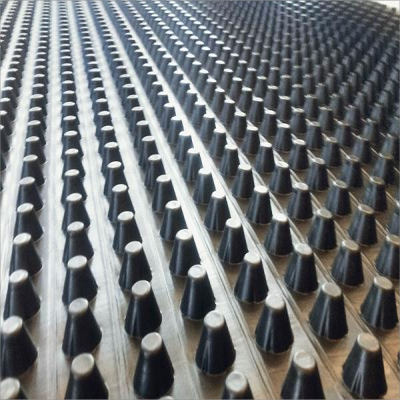Composite 3D Drainage plate It is a commonly used drainage material and can be used in roadbed, tunnel, landfill and other projects. It has a unique three-dimensional structure and excellent drainage performance.
1. Structural characteristics of composite three-dimensional drainage board
The composite three-dimensional drainage board is a drainage material composed of three-dimensional geonet core and upper and lower layers of non-woven fabrics. Its core part, the three-dimensional geonet core, is composed of a plurality of longitudinal and vertical main ribs and a layer of transverse (or oblique) ribs at the top and bottom. These ribs are staggered with each other to form a stable drainage channel. The upper and lower layers of non-woven fabrics can play the role of anti-filtration, protection and enhancement, so as to ensure that the drainage board maintains efficient drainage performance during long-term use.
2. Identification of front and back sides of composite three-dimensional drainage board
Although the composite three-dimensional drainage board has symmetry in the overall structure, it does have positive and negative sides in terms of design and use effect. Generally speaking, it can be identified from the following aspects:
1、Rib direction: Observe the direction of the ribs on the surface of the drainage board. Generally, the side where the longitudinal and vertical main ribs are located is the front side, while the side with more transverse (or oblique) ribs is the reverse side. The front design focuses more on drainage efficiency, while the reverse side pays more attention to anti-filtration and protection.
2、Surface flatness: Some drainage boards will undergo special treatment on the front during the production process, such as flattening or coating with anti-slip layer, etc., which can make the front surface relatively flat. Therefore, the front and back sides of the drainage board can also be preliminarily judged by touching the surface flatness.
3、Identification information: Some manufacturers will print specific identification information on the drainage board, such as “front”, “drainage board” and other words or patterns. These signs are generally located on the front, which is convenient for construction workers to quickly identify.
3. Precautions for use
1、Correct installation direction: During construction, make sure that the front face of the composite 3D drainage board is facing the direction that requires rapid drainage, such as the bottom of the roadbed or the inner wall of the tunnel. This maximizes the drainage efficiency of the drainage board.
2、Pay attention to overlap and fixing: the overlap between drainage boards should be carried out in strict accordance with the requirements of the specifications to ensure the width and quality of the overlap. It is also necessary to adopt appropriate fixing methods to firmly fix the drainage board on the foundation surface to prevent it from displacing or falling off.
3、Avoid damage: During the construction process, try to avoid mechanical damage or chemical corrosion to the drainage board. If you encounter sharp objects or corrosive substances, take protective measures to isolate them.
As can be seen from the above, the composite three-dimensional drainage board does have front and back sides. Properly identifying and installing the front and back sides of the drain board is essential to ensure its drainage efficiency and longevity. Therefore, in the process of purchase and use, construction personnel must fully understand the structural characteristics and identification methods of drainage boards, and carry out construction operations in strict accordance with the requirements of the specifications.
Post time: Feb-20-2025




